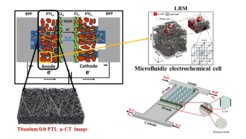Introducing one of our doctoral researchers: Supriya Bhaskaran
Research topic is the Lattice Boltzmann simulations and microfluidic experiment to study invasion processes in PEM water electrolyzer

Supriya Bhaskaran is one of our Ph.D. researchers and joined the IMPRS in October 2020. During her Master’s degree, she was introduced to the IMPRS Ph.D. program by her supervisor, which piqued her interest in joining the program to contribute to the field of research and to work in international grounds. She joined the group of Prof. Dr.-Ing. habil. Evangelos Tsotsas and Dr.-Ing. Tanja Vidakovic-Koch to research the topic of Lattice Boltzmann simulations and microfluidic experiments to study invasion processes in polymer electrolyte membrane (PEM) water electrolyzer. Since the demand for clean energy supply is still challenging to the scientific community today to mitigate global warming, her research is aiming to contribute to the promising technology of transforming renewable energy into a stable and reliable fuel form by electrochemical methods.
The PEM water electrolysis is a key technology which uses water as feedstock for hydrogen production. The scientific focus of Supriyas work is a combination of experiments and the Lattice Boltzmann model (LBM) in understanding the transport phenomena along with the coupled electrochemical kinetics in the frame of a pore-scale study inside the porous structure of the anode PEM water electrolysis. Further, tomography imaging techniques are used to visualize the gas-liquid distributions inside PTLs using LBM. However, the direct visualization of the two-phase transport in three-dimensional porous media is challenging due to the opacity of the material. One approach is to visualize the two-phase transport flow with a novel microfluidic cell. In this scenario, the 2-D representation of the porous media is used for analyzing the multi-phase flow inside the anode PTL. Lastly, an in-depth understanding of the coupling of the pore scale transport process and the anode electrode reaction kinetics is critical to understand the overall process. Hence, the effect of the catalyst layer microstructure on the anode OER reaction and electrochemical reaction consumption are analyzed based on using LBM.

This is Supriyas first international study abroad from her home country. At first, she had some difficulties travelling around the places and talking to people because of the challenges that a new language like German is bringing with it. But she was able to overcome these difficulties thanks to her mentors and German-speaking colleagues and friends, which helped her with the process of settling and starting the research. She finds the city of Magdeburg beautiful and describes the Elbe river as her highlight of the city.
Regarding the IMPRS program, she mentioned that her supervisors and mentors are invested and helpful. Especially the PAC system was described as helpful because her two supervisors and mentor (Dr.-Ing. Nicole Vorhauer-Huget) meet together and give different perspectives on the Ph.D. research topic. Since she is working at the Otto-von-Guericke-University most of the time, there wasn't much time to meet other Ph.D. researchers, but thanks to the annual IMPRS workshops it was nonetheless possible to meet other Ph.D researchers and to get details about their research and group. One suggestion she had is to have a short get-together every two months in person to know if everyone is doing well and sharing experiences with each other.
However, Bhaskaran would recommend the IMPRS program to fellow researchers and master students looking for opportunities to contribute to science and research.
To end this introduction, Supriya Bhaskaran had this nice comment: “I am thankful to everyone who took care of and supported the PhD researchers with time and energy to carry forward research and contribute to a better world. I personally feel I have gained a lot of experience and knowledge.“













